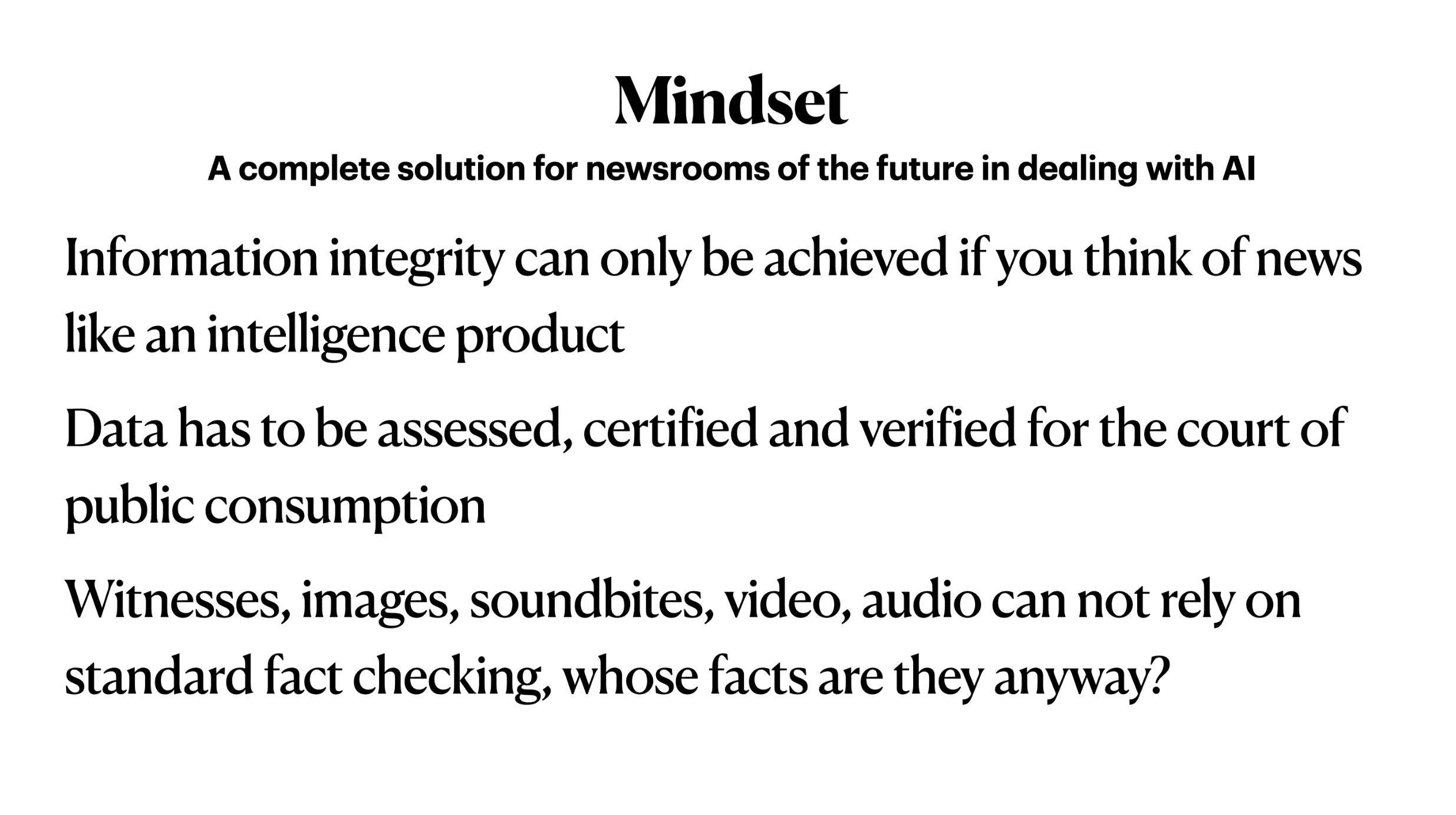Mis/Dis and The Newsroom of the Future
The newsroom of the future has to be versed in how to check the quality of information being shared and how to determine the degree of reliance on quality AI to augment decision-making.

There are dozens of key elections in the world this year, including US, Indian, Russian, South African, and Indonesian elections. Misinformation and disinformation will thrive. No doubt.
Mis and Dis are two totally different beasts. It’s important for journalists (and all of us) to recognize the difference.

Midjourney
Misinformation
According to Candyce Kelshall, President of the Canadian Association for Security and Intelligence Studies in Vancouver, misinformation is about sharing a particular, biased view of the world. It’s harmful, but a kind of ‘soft harm.’
E.g. If I receive information, there’s no need for me to check if it’s real, because that’s how I feel. I simply telegraph a perspective based on my emotions about the story or information. It’s real for me. It’s what I believe, so it’s true.
It’s a conscious choice to promote a particular world view with fellow believers
Disinformation
Disinformation, Kelshall says, is way more toxic because the intention is malevolent. It’s designed to do harm. It can be state-based (hurts the state and communities; hate-based (denigrates a group), or economic-based (wreaks economic chaos and financial harm).
It’s deliberate, planned, targeted, and polarizing
The newsroom of the future has to be versed in how to check the quality of information being shared and how to determine the degree of reliance on quality AI to augment decision-making. Additionally, according to Kelshall, journalists need to keep three things top of mind.
1. Keeping audience engagement by professional ethics
2. Keeping brand credibility through information integrity
3. Verifiable authenticity of reporters and anchors

Deck in progress for course on Newsrooms of the Future
There is an entire future newsroom ecosystem and model The Rundown is building out with the Canadian Association for Security and Intelligence Studies, Vancouver. We will be teaching a course on the platform. Coming soon.
Meanwhile, I asked Kelshall to suggest three tools all newsrooms need to look into to maintain information integrity. Here they are.
- Reverse image search
- How to spot misleading charts and data in visual form.
- An open source tool for tracking disinformation.
Obviously, there are a lot more, and they range in sophistication, and between paid and unpaid platforms. Non-journalists and communications teams should at least be aware of tools that can help us.
Claude (Opus) Generated Opinion Piece
We gave Claude a few prompts that included some original ideas through detailed prompts that capture the thrust of why we want to create this course on The Rundown and what needs to be done by news leaders. Below is the outcome. A short opinion piece by Claude in collaboration with us.
Here’s the audio read by myself, meaning my AI-generated voice from Eleven Labs. It took ten seconds to cut and paste the op-ed and generate it with ‘my’ voice.
Eleven Labs AI, Sous-Chef
In the age of artificial intelligence, misinformation, and deepfakes, newsrooms worldwide face an unprecedented challenge: maintaining the trust of their audiences while ensuring the integrity of the information they disseminate. As elections loom around the globe, the stakes have never been higher. To combat these threats and preserve the vital role of journalism in democracy, newsrooms must adapt and evolve. The solution? Embracing the mindset and practices of intelligence agencies.
Traditionally, newsrooms have relied on fact-checking to verify information and uphold the truth. However, in an era of ideological polarization and rapidly spreading misinformation, these methods are no longer sufficient. The advent of AI-generated content, such as deepfakes and manipulated media, has made it increasingly difficult to distinguish between what is real and what is not. Newsrooms must now contend with a new reality where the very nature of truth is under attack.
To address these challenges, newsrooms must adopt a more rigorous and systematic approach to information gathering, verification, and dissemination. This is where the principles and practices of intelligence agencies come into play. By treating news as an "intelligence product" that requires thorough assessment, certification, and verification before being released to the public, newsrooms can enhance the integrity of the information they provide and rebuild trust with their audiences.
One key aspect of this transformation is the implementation of a robust chain of custody for information. Just as intelligence agencies carefully track the origin and handling of sensitive data, newsrooms must establish clear protocols for documenting the source and provenance of every piece of information they collect. This includes leveraging technologies such as blockchain and hashing algorithms to create tamper-evident logs and ensure the authenticity of content.
Another critical component is the development of rigorous authentication frameworks that can keep pace with the rapidly evolving landscape of AI-generated content. By investing in advanced analytics tools and collaborating with experts in fields such as computer vision and natural language processing, newsrooms can stay ahead of the curve in detecting and combating deepfakes and other forms of manipulated media.
However, technology alone is not enough. To truly succeed in this new era, newsrooms must also invest in the skills and knowledge of their journalists. This means providing training in intelligence gathering techniques, data analysis, and digital forensics. It also means fostering a culture of critical thinking and healthy skepticism, where journalists are encouraged to question assumptions and dig deeper into the stories they cover.
Equally important is the need to educate and engage audiences. By being transparent about their processes and inviting readers and viewers to participate in the fact-checking process, newsrooms can build trust and create a shared sense of responsibility for upholding the truth. This may involve initiatives such as public fact-checking events, interactive data visualizations, and collaborative investigations that harness the collective intelligence of communities.
Ultimately, the goal is to create a news ecosystem that is resilient, responsive, and deeply committed to the pursuit of truth. By adopting the mindset and practices of intelligence agencies, newsrooms can position themselves as the trusted guardians of information in an age of uncertainty. They can provide the clarity and context that citizens need to make informed decisions and participate fully in the democratic process.
As the world enters a new era of information warfare, the role of journalism has never been more critical. By embracing the principles of intelligence gathering and prioritizing the integrity of information above all else, newsrooms can rise to the challenge and secure their place as the bedrock of democracy. The future of truth depends on it.
Interested to learn more?
Sign up today to get notified on the future of communication and AI
More from the blog
Sexism and Racism Loom Large for Large Language Models.
Do not trust an AI system to recruit talent on its own. Researchers have found LLMs are more likely to associate men with career-oriented words and women with family-oriented words.
Number Go Up
There are some lessons to share before you FOMO into crypto. I got burned, left for a while, and returned last year with a sober approach.
The Rundown Toolkit Alert
We wanted to make it easier for you by sharing vetted tools by the Rundown team that we use frequently and recommend. Enjoy.
On the Road With Cap Cut
We were able to subtitle quickly for social. We easily fixed the lighting and shadows. All of this was on our mobile phone. And on the move.